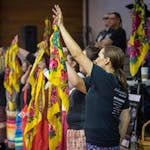Would you give a day of your time to save another person's life? Amy Ronneberg hopes you would. After seven years serving as chief financial officer of Be The Match, Ronneberg was named CEO earlier in June. The international nonprofit organization based in Minneapolis provides lifesaving blood stem cell therapy to people of all ages around the world. While such transplants have been done successfully for 30 years, treating more than 70 diseases, the concept remains a bit mysterious to many of us. Ronneberg, the mother of two children and a cancer survivor, breaks down the processes, busts some myths and shares a video to encourage us to consider becoming a match. Have your tissue ready.
Q: I think it's easier for people to understand a kidney or heart transplant. Might you explain the three kinds of bone marrow transplants?
A: Peripheral blood stem cell donation, or PBSC, is a nonsurgical procedure and the most common way to donate. Nearly 80% of the time, a donor will donate this way. Bone marrow donation is a surgical, usually outpatient, procedure. The donor receives anesthesia and feels little to no pain during the donation. Doctors use a needle to withdraw liquid marrow from the back of the pelvic bone via two small punctures. Umbilical cord blood is blood collected from the umbilical cord — not the baby — immediately after birth. The donated cord blood is tested, frozen and stored as a cord blood unit at a public cord blood bank for future use. Names of cord blood donors are never shared so that donation is completely anonymous. PBSC or marrow donors can usually meet after one year, if both the donor and recipient consent.
Q: How big is the registry?
A: We have more than 9 million U.S. donors on the registry; each year, we add 300,000 to 400,000 donors. We also work with over 50 international registries, with more than 35 million donors globally. We're truly an international organization.
Q: What percentage of donors are related by blood vs. strangers?
A: A matched sibling is typically the first option as blood stem cell matching is a far more complicated process than the more typical blood type matching. However, patients only have a sibling match 30% of the time. So, 70% of the time patients look to Be The Match for their lifesaving transplant.
Q: What diseases have the most success with these transplants?
A: More than 70 diseases can be treated with a blood stem cell transplant. For adults, typically leukemia and other bone marrow diseases are treated very successfully. In children, many life-threatening non-cancer conditions like sickle cell disease and immune system deficiencies are treated very successfully. The most common cancerous condition treated successfully is leukemia by far — mostly acute lymphoblastic leukemia.
Q: Around the time you became CFO, you were diagnosed with breast cancer. How did that change the way you saw your mission? And how are you doing now?
A: I'm doing great — cancer-free and feeling better than ever. Hearing the words "you have cancer" had a profound impact on me. Once you face something like that, your whole perception of life and work changes. The mission became very, very personal. I think about my two little girls and how I want a world where if they hear those three words, it's not a devastating message. Instead, the message they hear would be that science has advanced so far that a cure, or a vaccine, exists. I'm so proud that my time away from my family can be spent making sure other families have more time and life together.
Q: What compels people to donate?
A: Altruism. It's the chance to save someone's life. A day of your time and you have provided someone a chance to have more moments, more days, more life with their loved ones. It's very powerful.
Q: What are common concerns?
A: Scheduling, including assistance with child care, traveling large distances, being able to have companions with them, the logistics of hotels and airfare. We take care of all of that.
Q: I recall hearing that bone marrow transplants are very painful. True?
A: Unfortunately, television shows have misrepresented the donation process in the past for a good story line. With PBSC, individuals may experience soreness and aches in some of their bones. For bone marrow, the donor is put under general anesthesia for an outpatient procedure. Often donors say that where the marrow was removed they are sore, like they bumped into the side of a table. Most are back to normal routines in a few days.
Q: How are you addressing racial inequities regarding donations?
A: If you're a white patient in the U.S., you have a 77% chance of receiving a transplant. Black and African-American patients have a 23% chance. That's an astounding gap. There simply aren't enough black or African-American donors on the registry. We have significantly increased our outreach, education and funding in black communities across the country. Our vision is to democratize cell therapy by providing equal outcomes for all.
Q: What would you like to tell readers considering becoming a donor?
A: Imagine for a moment that you, your sister or brother, your mom or dad, your child or your best friend needed an unrelated bone marrow transplant. And there was someone in the world that was their perfect match. But this video of 10-year-old Laila Anderson tells the story much better than I can in words. Laila was battling a rare blood disease and needed a bone marrow transplant to survive. This is the moment Laila and her parents were able to meet Kenton, her donor: youtube.com/watch?v=VbjwBhaeN5I



![Brock Ray of New Hope worked alongside his daughter Bonnie, 7, to line up materials for the feminine hygiene kits. ] ANTHONY SOUFFLE • anthony.](https://arc.stimg.co/startribunemedia/V7NEHZM6GZ2X6LNJ3HORH5RERE.jpg?w=75&h=75&fit=crop&crop=faces)

